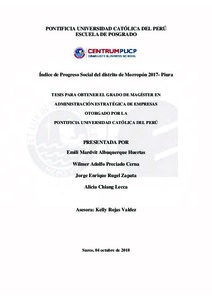| dc.contributor.advisor | Rojas Valdez, Kelly | |
| dc.contributor.author | Albuquerque Huertas, Emili Mardvit | es_ES |
| dc.contributor.author | Preciado Cerna, Wilmer Adolfo | es_ES |
| dc.contributor.author | Rugel Zapata, Jorge Enrique | es_ES |
| dc.contributor.author | Chiang Lecca, Alicia | es_ES |
| dc.date.accessioned | 2018-12-17T23:10:40Z | |
| dc.date.available | 2018-12-17T23:10:40Z | |
| dc.date.created | 2018 | |
| dc.date.issued | 2018-12-17 | |
| dc.identifier.uri | http://hdl.handle.net/20.500.12404/13163 | |
| dc.description.abstract | El progreso social es un tema muy importante para el desarrollo de las naciones y
cada vez se vuelve más relevante para las instituciones públicas y privadas en el Perú,
especialmente a nivel de distritos. En este escenario, nace la prioridad de adquirir
información confiable en la búsqueda de generar el desarrollo en el Índice de Progreso Social
(IPS) a partir del análisis de tres dimensiones: (a) Necesidades Humanas Básicas, (b)
Fundamentos del Bienestar, y (c) Oportunidades. El IPS permite evaluar la eficacia del éxito
económico de un país traducido en progreso social; este enfoque supone que el Estado debe
ser capaz de satisfacer las necesidades básicas de sus habitantes, proporcionando los
elementos fundamentales para mejorar y mantener su calidad de vida, creando condiciones
para que todos ellos desarrollen su potencial. Asimismo, el IPS representa un indicador viable
y confiable para que el Gobierno y entidades privadas puedan, a partir de sus esfuerzos,
medir los resultados obtenidos, mediante las inversiones realizadas, en las aplicaciones de
políticas y acciones correctivas.
La medición realizada en el distrito de Morropón dio como resultado un Índice de
Progreso Social con 56.02 puntos, que lo ubica en un nivel “Medio bajo”. Antes de obtener
esta cifra, la Municipalidad del Distrito de Morropón ya había elaborado el Plan de
Desarrollo Concertado al 2021 amparándose en el Plan de Desarrollo Regional Concertado
de Piura (PDRC), que contempla 07 objetivos estratégicos, de las cuales seis se señalan en el
presente estudio. El PDRC promueve la economía local mediante variables que buscan
reducir la brecha de las necesidades básicas del distrito. Dentro de los componentes se
contemplan: (a) agua y saneamiento, (b) vivienda, (c) acceso a la información y
telecomunicaciones, y (d) tolerancia e inclusión, donde los ciudadanos más desprotegidos
tendrán la prioridad de atención. | es_ES |
| dc.description.abstract | Social progress is a very important issue for the development of all nations and it is
becoming more and more relevant for the public and private institutions in Peru, mainly at the
district level. In this scenario, the priority of acquiring reliable information arises in the
search for generating the development in the Social Progress Index (SPI) starting from the
analysis of three dimensions: (a) Basic Human Needs, (b) Foundations of Wellbeing, and (c)
Opportunities. The SPI allows assessing the effectiveness of the financial success of a
country translated into social progress; this focus implies that the State should be capable of
satisfying the basic needs of its inhabitants, providing the basic resources in order to improve
and keep their living standards, creating the conditions for all of them so as to develop their
potential. Likewise, the SPI represents a feasible and reliable indicator for the government
and the private institutions so that they may be able, based on their own efforts, to measure
the results obtained, through the investments made, in the applications of policies and
corrective actions.
The measurement applied in the district of Morropón resulted in a Social Progress
Index of 61.57 points, which locates it in a "Low medium" level. Before obtaining this result,
the Municipality of the District of Morropón had already elaborated the Concerted
Development Plan towards 2021 under the Concerted Regional Development Plan of Piura
(CRDP) 2016-2021, which considers 07 strategic variables, where six stand out in this study.
The CRDP promotes the intervening local economy variable that aims at reducing the gap of
the basic needs of the district. Among the components observed are the following: (a) water
and sewage, (b) housing, (c) access to information and telecommunications, and (d) tolerance
and inclusion, where the most vulnerable citizens will be prioritized. | es_ES |
| dc.language.iso | spa | es_ES |
| dc.publisher | Pontificia Universidad Católica del Perú | es_ES |
| dc.rights | info:eu-repo/semantics/openAccess | es_ES |
| dc.rights.uri | http://creativecommons.org/licenses/by-nc-nd/2.5/pe/ | * |
| dc.subject | Indicadores sociales--Perú--Morropón (Piura : Provincia) | es_ES |
| dc.subject | Indicadores económicos--Perú--Morropón (Piura : Provincia) | es_ES |
| dc.subject | Investigación cuantitativa | es_ES |
| dc.title | Índice de progreso social del distrito de Morropón 2017- Piura | es_ES |
| dc.type | info:eu-repo/semantics/masterThesis | es_ES |
| thesis.degree.name | Maestro en Administración Estratégica de Empresas | es_ES |
| thesis.degree.level | Maestría | es_ES |
| thesis.degree.grantor | Pontificia Universidad Católica del Perú. CENTRUM | es_ES |
| thesis.degree.discipline | Administración Estratégica de Empresas | es_ES |
| renati.discipline | 413307 | es_ES |
| renati.level | https://purl.org/pe-repo/renati/level#maestro | es_ES |
| renati.type | https://purl.org/pe-repo/renati/type#tesis | es_ES |
| dc.publisher.country | PE | es_ES |
| dc.subject.ocde | https://purl.org/pe-repo/ocde/ford#5.02.04 | es_ES |






